Main line • Night train • Autria • OBB • Nightjet
See also: ÖBB Railjet
Note: this page is for educational purposes only. It is not a substitute for the official page of the operating company or manufacturer.
Nightjet is the brand name for the night trains operated by ÖBB-Personenverkehr AG, a wholly-owned subsidiary of the ÖBB holding company. This branding is part of the overall ‘Jet’ concept – along with Railjet and Cityjet – which is the marketing line for ÖBB’s passenger traffic. Nightjet is therefore not a private company, but manages its entire business, at market prices and with no public service obligations. But where did this idea come from?
Austrian night trains already had a good reputation before the new Nightjet branding. The concept is based on foreign news. In 2015, Deutsche Bahn decided to abandon its City Night Line trains, equipped with sleeping cars and couchette carriages. Representing barely 4% of traffic, with annual sales of 90 million, the German group reported a loss of 30 million euros. A controversy later arose over the veracity of these figures: night-time passengers with seats were counted as ‘daytime intercity passengers’, which distorted the ridership figures.
Operator: ÖBB-Personenverkehr AG
Subsdiary / Division: 100% ÖBB Holding
Sector: Passengers
Commercial segment: Main Line
International Transport: yes
First services: december 2016
Type of train : pushed/pulled trainset
Manufacturer(s) : Siemens
Traction : ÖBB
Official website : https://www.nightjet.com
Social media :
Faced with the giant Deutsche Bahn, the small ÖBB is flexing its muscles throughout Central Europe and the Alps, and entering the big league. And since Vienna, Zurich, Venice and Budapest are a long way from the Europe of high-speed trains and intensive Paris-Brussels traffic, the night train automatically becomes an alternative in a vast region where there will probably never be a TGV.
Rebuilding the offer
« Wisst ihr eigentlich, was ihr da tut? – Do you actually know what you’re going? ». That’s the question Kurt Bauer, head of long-distance transport at ÖBB, has been asked 1,000 times. This ambitious young director immediately stressed that he is not nostalgic for the night train: ‘I’m an economist,’ he explained to Die Zeit in December 2017. ‘The failure of the Germans is an opportunity for the ÖBB’. How is it that something ruinous for Deutsche Bahn becomes profitable for the Austrians? ‘As a small railway, we also have to adopt unconventional methods,’ replied Kurt Bauer soberly. He also explained that, of the 34 million long-distance passengers, 1.4 million travel only by night train, but they account for 15 to 20% of turnover. ‘So you simply can’t talk about a niche market with such financial results,’ continued the economist.
However, the arrival of the Austrians with the Nightjets was a rather hasty action, despite prior studies to renew the concept of the night train. A test had been carried out on the EN 471 Hamburg-Zurich, concerning service, catering and a number of operational details. The German decision brought things to a head and everything had to be put in place in just a few months, which represents the speed of sound in a railway world used to slow decision-making. We had to develop a dynamic new brand, a cutting-edge marketing strategy and a host of new ideas to satisfy the tastes of the 21st century. A challenge that requires experienced people. So the ÖBB invested €40 million in the new ÖBB Nightjet brand, buying 15 German sleeping cars and 42 German sleeping cars and adding them to their own fleet. In total: 74 couchette cars, 52 sleeping cars and around 63 seating cars, i.e. 189 vehicles to be repainted in the new Nightjet concept livery.
December 2016: launch of the service

Let there be no mistake: not all Deutsche Bahn’s night trains were taken over, and only the best connections survived. The ÖBB took over the famous double-decker sleeping cars of the former City Night Line, which the ÖBB continued to operate on the Zurich-Berlin and Zurich-Vienna routes. So some routes never stopped, just changed operators…
‘On the evening of the takeover, we quickly stuck our ÖBB sticker on the cars’, explains Kurt Bauer, ‘and then we started straight away’. Other routes, such as Vienna-Amsterdam, disappeared from the night train network… It should be noted that although the ‘Euronight’ label disappeared from the ÖBB, it remained in force for night trains not operated by the ÖBB, such as those operated by HŽ (Croatia), MÁV (Hungary), PKP (Poland) and České dráhy (ČD, Czech Republic). Some of these trains have been designated ‘partners’ by the ÖBB because they are close to Nightjet comfort standards, in particular with the Comfortline sleeping cars purchased in large numbers by Central European networks, including Deutsche Bahn.
The start of the service, on the evening of 11 December 2016, adopts certain operating principles, such as multi-destination car blocks, a technique designed to massify several groups of cars to form a single train. Some groups of Euronight cars travel with Nightjet trains. As the ÖBB benefits from advantageous fares on Austrian soil, we have seen groups of cars make long detours to benefit from both massification and advantageous tolls. This is particularly the case for Vienna-Venice cars that pass through Salzburg and Villach, or Rome-Munich cars that also pass through Villach and Salzburg rather than Innsbruck, a more direct route.
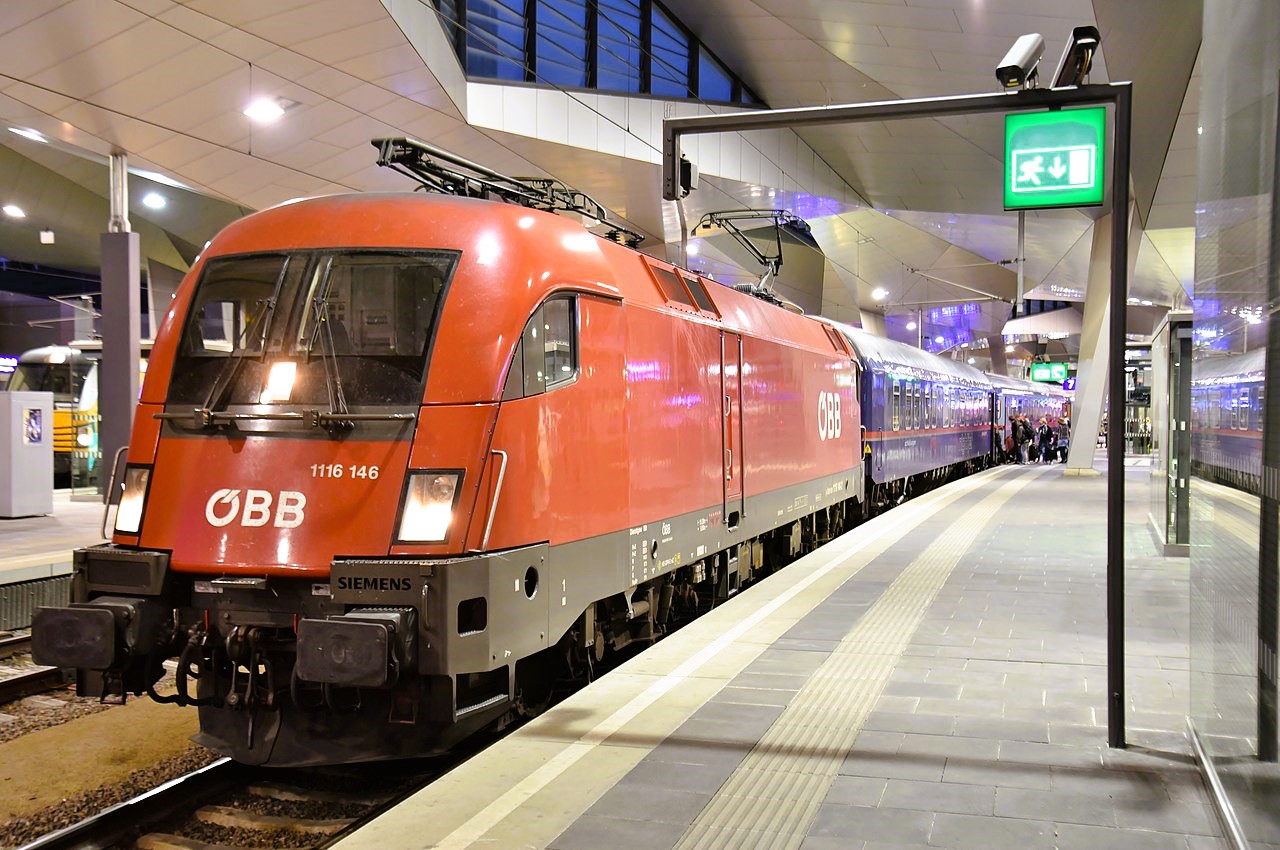
Making Vienna a new hub is clearly the objective of the ÖBB, which is thus imposing its brand throughout Mitteleuropa, at the crossroads of a vast Poland/Czech Republic/Hungary area with the Croatia/Italy ‘Adriatic block’, not forgetting the Alpine arc with Switzerland. With these converging flows, every evening at Vienna’s central station, the brand new Hauptbahnhof, there were no fewer than five Nightjet departures:
- 7.23pm: NJ 233/232 Vienna-Rome and Vienna-Milan via Villach (unbundled at Tarvisio) ;
- 8:41pm: NJ 490/40490 Vienna-Düsseldorf and Vienna-Hamburg (unbundled at Nuremberg);
- 9:27pm: NJ 466 Vienna-Zurich and Vienna-Venice (unbundled at Salzburg with cars from Budapest and Prague!);
- 10:55pm: NJ 246, the only domestic train, Vienna-Bregenz (on Lake Constance);
On summer Fridays at 8.23pm, there is also the ARZ (TAA with cars) NJ 1237/1239 Vienna-Livorno.
As far as Austria is concerned, the only coupons that avoid the capital are :
- NJ 420 Innsbruck-Hamburg/Düsseldorf (unbundled and rearranged with NJ 490 at Nuremberg);
- NJ 464 Graz-Feldkirch/Zürich, which picks up Euronight Zagreb-Zurich cars en route.
Finally, the only pair of Nightjets that did not involve Austria was – and still is – the NJ 470 Zurich-Berlin/Hamburg, one of the highest earners on the entire list. It is one of only two night trains still operating in Switzerland, although the third, the ex-Thello Paris-Venice, crossed the Valais in the middle of the night with no commercial operations in the area. At the time, the Nightjet service looked like this:
Nightjet has not abandoned its neighbours, however. A network of partners completes the ‘Mitteleuropa’ network, taking its sleeper cars as far as Warsaw, Budapest, Rijeka and even Zagreb. This is how Zurich obtains, through the ‘coupon’ game, direct carriages to Zagreb, Graz, Vienna, Budapest and even Prague via Linz, groups of carriages that are passed from one train to another for an acceptable timetable.
Expansion and new rolling stock
The good performance of traffic in 2017 quickly led to a demand to extend services to other countries, in particular the Benelux countries and Paris. But this required additional rolling stock and entailed additional costs in terms of crew time on board.
One of the objectives was to serve Berlin, an increasingly popular tourist and business destination. The 2019 timetable thus sees a new addition of Nightjets cars:
- 10.10pm: NJ 456 Vienna-Berlin and Vienna-Warsaw via Breclav (in reality this is the ex-‘Chopin’ with unbundling at Bohumin), with cars to Warsaw remaining managed by PKP under the Euronight label.
This gave 5 night trains from Vienna (6 on Saturdays in summer with the Vienna-Livourne), not including the Dacia to Bucharest, also a Euronight. Clearly, Vienna was retaining its position as a hub for night train traffic.
New rolling stock
Even before the Nightjet concept was launched, in February 2016 the ÖBB presented a bold reconfiguration of the sleeper compartments. In spring 2017, an invitation to tender was launched for almost €400 million worth of rolling stock, including Railjets, the daytime intercity trains. In detail, the ÖBB intended to acquire 21 trainsets WITH locomotives – which is new – giving a total of 160 cars for 10 daytime Railjet trainsets and 13 seven-car trainsets for Nightjets. The invitation to tender included cars with driver’s cabs and low-floor multifunction cars, capable of running at speeds of up to 200 km/h in Austria, Germany, Switzerland and Italy. The final decision came in August 2018 with the signing of a framework contract and an initial order worth €250 million from Siemens Transportation (now Siemens Mobility), whose only factory that builds international cars is located… in Vienna.
2020 : Brussels and pandemic…
The good performance of traffic from 2017 quickly led to a demand to extend services to other countries, in particular the Benelux countries and Paris. But this required additional rolling stock and entailed additional costs in terms of crew time.
One of the objectives was to serve Berlin, an increasingly popular tourist and business destination. The 2019 timetable thus sees a new addition of Nightjets cars:
- 10.10pm: NJ 456 Vienna-Berlin and Vienna-Warsaw via Breclav (in reality this is the ex-‘Chopin’ with unbundling at Bohumin), with cars to Warsaw remaining managed by PKP under the Euronight label.
This gave 5 night trains from Vienna (6 on Saturdays in summer with the Vienna-Livourne), not including the Dacia to Bucharest, also a Euronight. Clearly, Vienna has retained its position as a hub for night train traffic.
The plans drawn up in autumn 2019 included a link between Vienna/Innsbruck and Brussels, by diverting the twice-weekly Vienna/Innsbruck-Düsseldorf to Aachen and Brussels. This route was officially opened on 20 January 2020.
Unfortunately, as was the case for all the operators in Europe, this extension to Brussels was short-lived, because in mid-March, health restrictions were in force just about everywhere in Europe. Brussels and other destinations were closed to traffic in turn, leading to several months of unemployment for Nightjets.
Services resumed with the easing of restrictions in the summer and autumn of 2020, but new restrictions were introduced in November for a nightmare year that everyone was anxious to forget.
Plans in spite of everything
In the meantime, the ÖBB placed a second €500 million order with Siemens for 20 seven-car Viaggo Nightjet trains. Each trainset has a capacity of 100 seats and 160 couchette seats, and comprises two sleeping cars, three couchette cars and two seating cars. This new order brings the total number of cars in the fleet to 231, including sleeping cars, couchette cars and seat cars. These trains, like those ordered in 2018, comply with the new Italian anti-fire regulations for tunnel passages.
In addition, the project to launch a new Nightjet to Amsterdam was postponed with the second wave of epidemics.
2021 : Amsterdam, Zurich, Paris and new cars
Despite the crisis, on 23 February 2021 Siemens and ÖBB presented a first painted cauldron of the brand new Nightjet cars, not yet fitted with the interior fittings.
In the spring of 2021, with inoculations in Europe well advanced, Nightjet services were gradually resumed from Vienna. The train to Brussels returned on 25 May 2021 with a new timetable, but without the Innsbruck section. This train was now shared with a new section to Amsterdam. On this leg were Austria’s Minister for Climate Protection, Leonore Gewessler, and ÖBB CEO Andreas Matthä, arriving in the Dutch capital the following morning. The service was welcomed by the Dutch Secretary of State for Infrastructure and Water Management, Stientje van Veldhoven, and the President of the NS, Marjan Rintel. On the train to Brussels was Michaela Huber, at the time a member of the Executive Board of ÖBB-Personenverkehr AG. The ÖBB were keen to launch a charm offensive and demonstrate their determination despite the continuing pandemic.
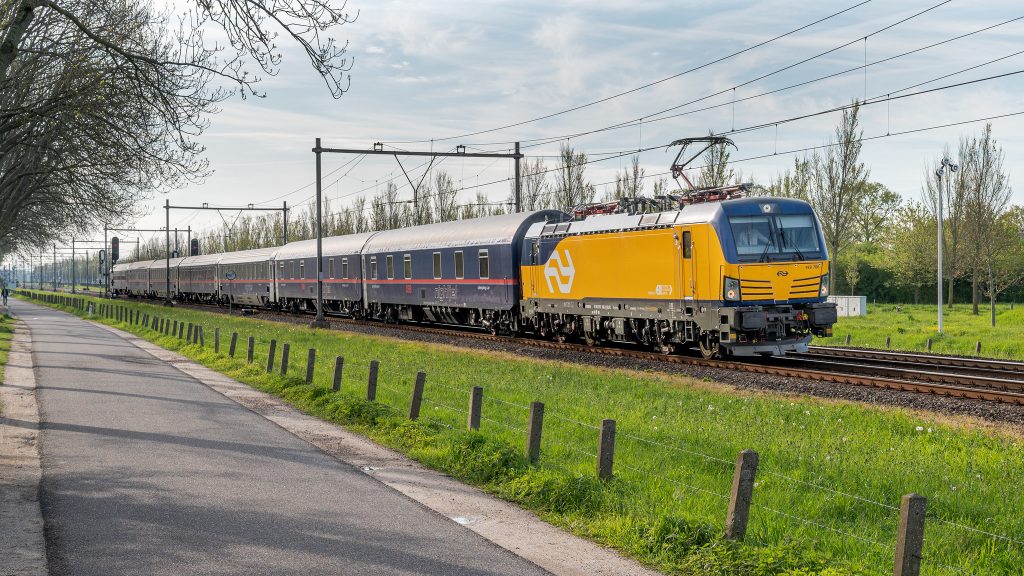
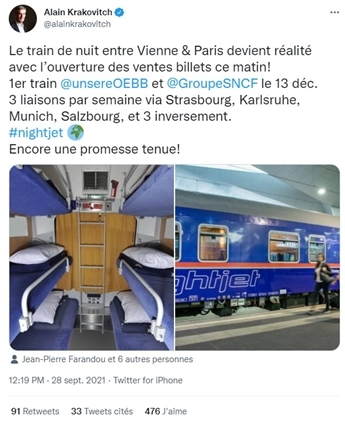
In the footsteps of the old Orient-Express
In September 2021, the opening of ticketing on the Vienna-Paris route marked the implementation of the partnership between SNCF and ÖBB (see tweet from Alain Krakovitch, Director General of Voyages SNCF). Signed in 2020, this partnership provided for a joint route between Vienna and Mannheim, with the Brussels section no longer part of the Amsterdam Nightjet, which for its part took another route associated with the future Amsterdam-Zurich…
To get to Cop26 in Glasgow at the beginning of November 2021, the Austrian Transport Minister (Green) Leonore Gewessler did not hesitate to promote the train by making the full round trip, Nightjet + Eurostar + Avanti.
Amsterdam-Zurich
In the wake of a partnership agreement signed in December 2020, SBB, ÖBB and NS (Netherlands) are relaunching a night train that once existed between Zurich and Amsterdam. The innovation is that this train will include a block of cars with seats in Basel, which Deutsche Bahn will manage commercially as part of its night-time ‘ICE’ service.
2022 – 2023 : new services, new rolling stock
From December 2022, the Vienna-Milan section was extended to Genoa and La Spezia, adding several new destinations to an already extensive network. Meanwhile, a number of new Nightjet and Railjet coaches continued their trials in Austria and Germany.
December 2023 was undoubtedly a high point for Nightjet, with the launch of :
- New routes between Paris and Berlin as well as Brussels and Berlin, on a three-weekly basis;
- But above all, the launch of the long-awaited new Siemens trainsets on the Vienna-Hamburg route.
This milestone also underlined the cooperation between ÖBB and a number of public operators, such as DB, SNCF and SNCB, as illustrated by the photos below (left, photo by ÖBB press). The most visible feature was the addition of the logos of the three partner companies to the cars.
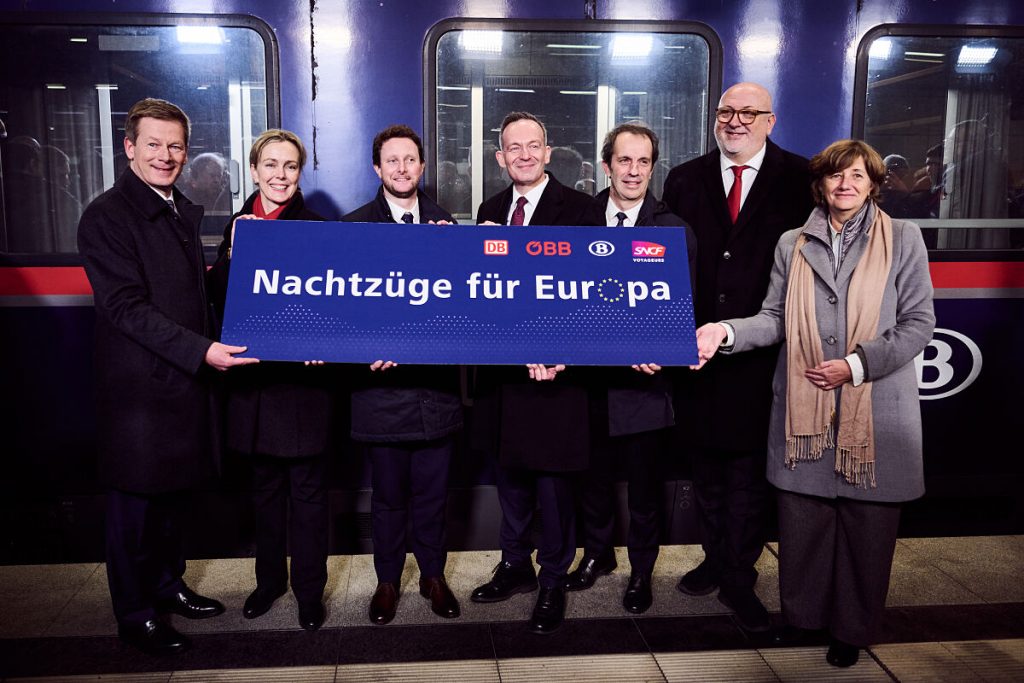

Originally scheduled for 2020, the new Siemens trains were finally put into service for the first time on the Vienna – Hamburg and Innsbruck – Hamburg routes. However, they were not given the go-ahead by the ERA until 24 November 2023, just a few days before the official start of commercial operations. What was new was the layout of the sleeping cars, and above all the introduction of what are known as individual ‘mini-cabins’ (photo right).
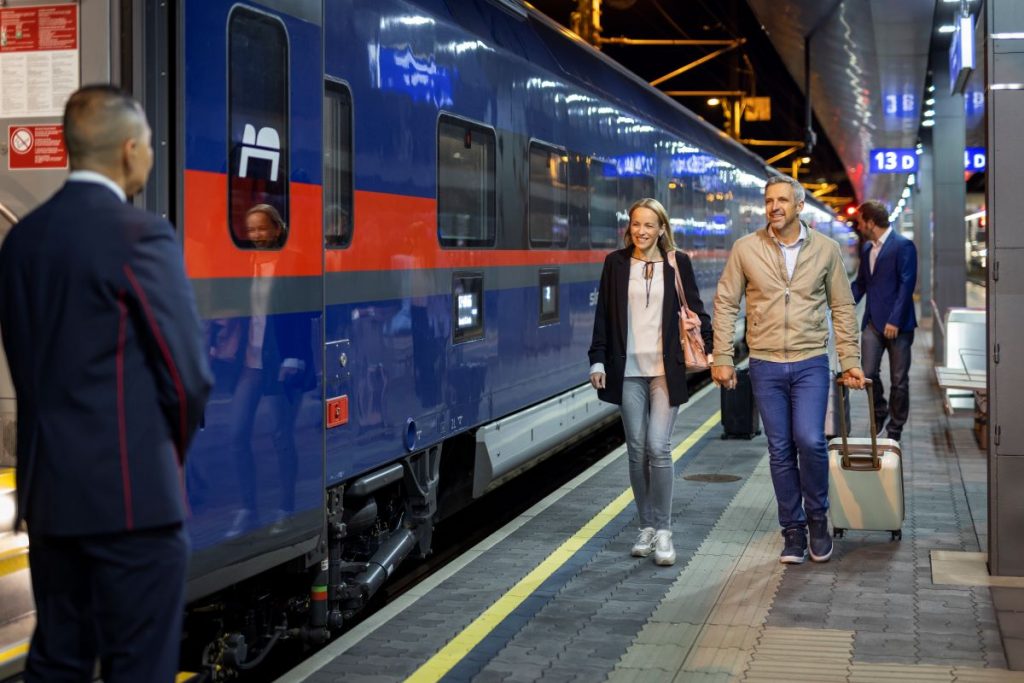
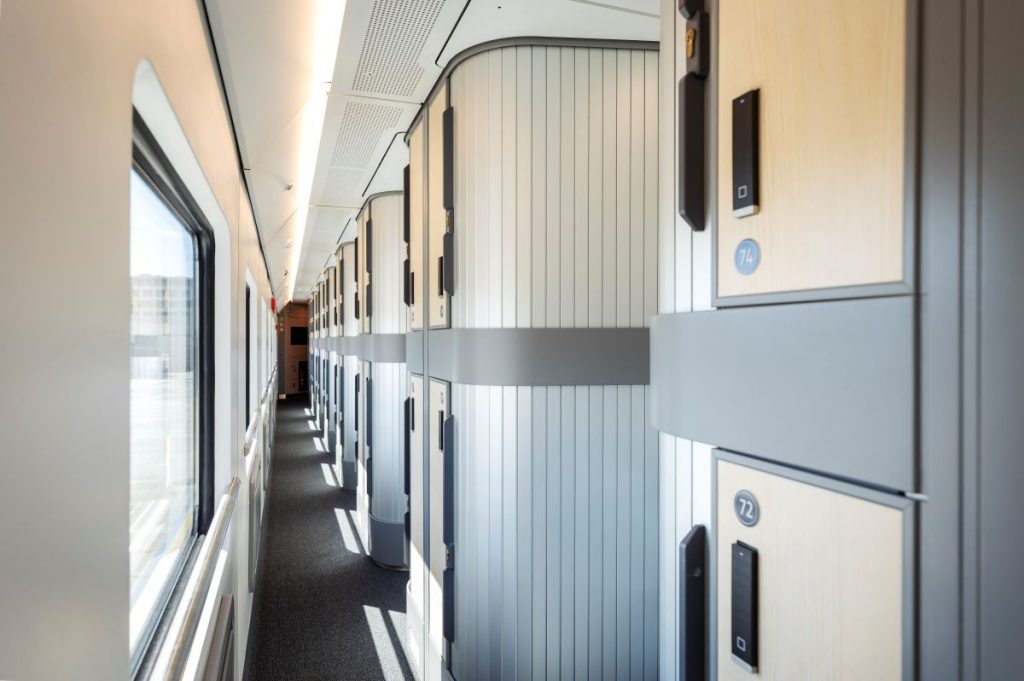
🟧
[TOP]
Main line • Night train • Autria • OBB • Lexical
